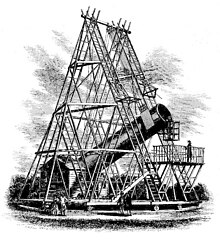40-foot telescope

William Herschel's 40 foot telescope, also known as the Great Forty-Foot telescope, was an optical telescope constructed between 1785 and 1789 at Observatory House in Slough. It was used to discover the 6th and 7th moons of Saturn. It was dismantled in 1840; today the original mirror and a 10 foot section of the tube remains.
Construction
The telescope was constructed by Sir William Herschel, as well as by Johann Herschel and Caroline Herschel, between 1785 and 1789 in Slough, with components made in Clay Hall near Windsor. The tube was made of iron. It was paid for by King George III, who granted £4,000 for it to be made.[1]
Use
The telescope was located on the grounds of Observatory House, Herschel's house in Slough, between 1789 and 1840.[1] It was a local tourist attraction,[2] visited by rich and famous people on their way to the nearby Windsor Castle to visit the King,[3] and was featured on Ordinance Survey maps.[2]
As part of the funding deal with the telescope, Caroline Herschel was ranted a pension of £50 per year to be William's assistant. As a result, she was the first woman in England to be paid to carry out astronomy.[1]
The one achievement of the telescope was to discover the 6th and 7th moons of Saturn, although this is debatable as Herschel used other telescopes at the same time.[1]
The final observation made by the telescope was in 1815.[1]
Mirrors
Two 48-inch concave metal mirrors were made for the telescope. The first was cast in 1785, and was made of speculum with arsnic to improve the finish. The mirror weighed half a ton, but was too thin to hold its shape once t had been ground and polished. A second, heavier mirror was cast a few years later, and this was used rather than the original.[3]
Decommissioning
The telescope's frame was dismantled in 1840 by William Herchel's son, John Herschel,[1] on his return from carrying out observations in South Africa. It was dismantled as it was feared that the frame might collapse due to rot, and John feared for the safety of his young children. A small ceremony was conducted to commemorate its dismantling.[4]
The tube was left lying in the garden, where 30 years later the tube was crushed by a falling tree. The remaining piece of the tube is a 10 foot length of the speculum end, which is 3048 by 1465 mm and is located in the Herschel Collection of the National Maritime Museum, Greenwich, London.[1]
References
- ^ a b c d e f g "40-foot Herschelian (reflector) telescope tube remains (AST0947)". National Maritime Museum. Retrieved 22 November 2008.
- ^ a b "Herschel's Grand Forty feet Reflecting Telescopes (ZBA4492)". National Maritime Museum. Retrieved 22 November 2008.
- ^ a b "Original mirror for William Herschel's 40 foot telescope, 1785". Science & Society Picture Library. Retrieved 22 November 2008.
- ^ "'Slough. The 40ft reflector with all the woodwork down' (PAF7451)". National Maritime Museum. Retrieved 22 November 2008.
